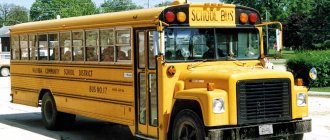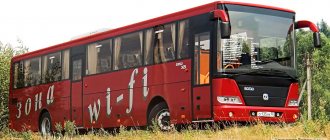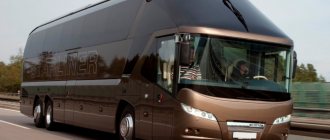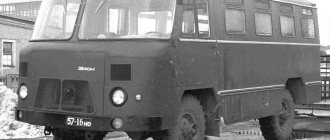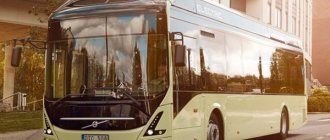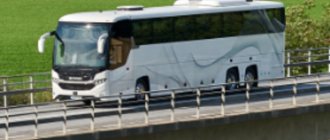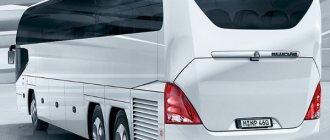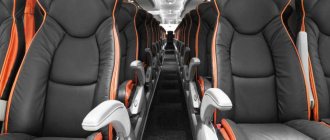Alexey Starikov Photos by the author, John le Bue, John Eagle, Natalia Chernyavskaya
Buses of America: intercity and tourist Buses of America: city I Buses of America: city II Buses of America: school
The bus industry, uniform throughout North America, is even more distinctive than many others. Unlike trucks, which are popular in many countries around the world, local buses are little known abroad. At the same time, bus transportation on the North American continent is more popular than anywhere else.
Almost all cities in the USA and Canada are connected by intercity routes. For almost a hundred years now, the industry has been rapidly developing according to its own laws, without the influence of the rest of the world. Local intercity buses also differ from their counterparts in appearance - with a long wheelbase, short overhangs, increased width, and level of comfort. However, only a few specialized companies produce them. Since two companies played a key role in the development of modern bus transportation on the continent, the story should begin with them.
American backlog
The emblem of the first of these, the running hound, is well known to many; It is the world's largest Greyhound bus operator. Having started in 1914 with the transportation of miners in one car, today the company provides 13 thousand flights per day in the USA, Canada and Mexico, carrying up to 25 million passengers per year. It is clear that Greyhound Lines is the largest buyer of buses on the market, and it is the company that manufacturers are targeting.
The second company is also well known in the automotive world - this is the General Motors concern. Its commercial vehicle division, GMDD (Diesel Division), revolutionized the bus industry in the 1930s, setting the tone for all others. For half a century, cars of this particular brand dominated the intercity transportation market. Several series were produced specifically for the same Greyhound.
The concern's first intercity car was the cabover model 719, created in 1936 by Yellow Coach, part of GMDD. It was a 41-passenger bus with an aluminum semi-supporting body, equipped with a Detroit Diesel 707 CID diesel engine (this brand also belonged to GM).
After the war, the famous series of 37-seater GM PD3751 Silversides buses appeared, on which corrugated aluminum sides first appeared, and you can still recognize the American airliner by them. They were equipped with the famous 2-stroke Detroit Diesel 6-71 diesel engine, they had increased capacity of luggage compartments under the cabin. At the same time, toilet cabins appeared on American intercity buses.
Subsequent series of GM Scenicruiser, Buffalo and Challenger buses featured air suspension, automatic transmissions, air conditioning and bunk seating. The department's machines were market leaders until its closure in 1979.
Of course, besides GM, there were other manufacturers of intercity cars in America. They were made by Blue Bird, Fageol, FitzJohn, Flxible, Mack, Pullman, Twin Coach, Wayne and many others. Europeans are also trying to sell their cars here - Neoplan, Van Hool, LAG, but they have not achieved much success. Currently, only a few companies, listed below, operate in the United States and Canada.
How to find travel accommodation?
To find the best hotel accommodation options, it is best to use the hotellook resource. This site searches for available rooms at more than 700,000 hotels in 205 countries, showing offers from 67 booking systems. Another similar service is Tripping. It always makes sense to check prices on both search engines; prices for the same offers may differ slightly.
An excellent way to save on housing without losing comfort is to rent an apartment, house or room from a private owner. The amazing Airbnb project was developed especially for this purpose. If you don’t know what this is, then be sure to read my article AIRBNB rental housing. Especially booking through Airbnb helps to save significantly on trips to Russia and the countries of the former USSR. By the way, if you have never used this service before, you can get a discount of 2,100 rubles on your first booking by following this link.
Useful links:
Dream route! Traveling through California, Nevada and Arizona by car. A trip to New York on your own. Travel planning. The best travel websites and apps. Across the USA by bus. From New York to Chicago. Across the USA by bus. New York - Philadelphia. Across the USA by bus. Washington - Cleveland. Across the USA by bus. Chicago.
Motor Coach Industries International Inc.
The leading American manufacturer of intercity and tourist buses is Motor Coach Industries International Inc. (MCII) - was founded in 1932 in Canada by entrepreneur Harry Zoltok. The first bus was an 11-seater vehicle on a premium Packard chassis. However, after 4 years the buses received their own chassis. And in 1939, deliveries of vehicles began for the Greyhound transport company. This large series was called Courier and was produced in 12 versions from 50A to 200V.
In 1958, the company was purchased by Greyhound, which opened a second plant in North Dakota. A third branch opened ten years later in New Mexico under the name Transportation Manufacturing Corporation (TMC). They assembled various cars, including Challenger models purchased from GM, once the largest supplier of Greyhound.
The classic machines were the MC1–MC9 series, which set the standard for the entire industry. Two- and three-axle vehicles with aluminum bodies with an overall length of up to 13.5 m could accommodate up to 50 passengers and were equipped with “Big Three” engines of varying power. The MS-6 with its extremely unusual design attracted particular attention from the public. From 1967 it was produced exclusively for Greyhound under the name Supercruiser. Other classic cars were produced under the names MC-7 Combo and Freighter, MC-8 Americruiser, MC-9 Crusader.
Many cars of those years, having traveled millions of miles, served various societies and organizations, were converted into motor homes or exported to Latin American countries. Then the corporation went through several reorganizations, coming under the control of the Mexican company DINA in 1994. As a result, the DINA Viaggio Confort model appeared in production at the plant for the USA.
Since 1998, a completely new Renaissance model went into production. It featured an advanced Wabco ECAS air-controlled suspension system with fast/slow ride stiffness switching. In addition, the kniling system – “squats at stops” – appeared for the first time. And the third steering axle ZF RAS reduced the turning radius. For better comfort, the cabin air conditioning system had three separate zones - for the driver and passengers on each side.
At the beginning of 2000, new series F35, G41 and G45 were launched. Currently in production are D and J Series models in 40 and 45 ft (12.2 and 13.7 m) lengths and 2.4; 2.5 or 2.6 m.
Jefferson Lines
Jefferson Lines Bus
Another very large carrier that carries out transportation throughout the central part of America. Jefferson Lines currently covers 14 states: Arkansas, Iowa, Wyoming, Wisconsin, Kansas, Minnesota, Missouri, Montana, Nebraska, North Dakota, South Dakota, Oklahoma, Texac and Winnipeg, Canada.
Prevost
The company was founded in 1924 by Canadian Eugen Prevost after he had the opportunity to make a passenger body on the chassis of an REO truck, because he was a carpenter by profession. It is not surprising that until 1940 all bus bodies (like many other bus manufacturers) were wooden. It was only in 1945 that they first began to be made of metal, but the racks remained wooden.
In the 1950s, it was decided to focus on tourist ships. The first model of this type was Le Normand (1957) with aluminum sides, diesel engine and air suspension.
After 9 years, it was replaced by the more impressive Super Panoramique (length 12.2 m, width 2.6 m). After restyling, it received the name Champion and became the first bus on the continent with an integral body.
And in 1968, the first of its own style buses, Panorama, appeared, with curved side windows that extended onto the rounded roof. He, like his followers Mirage XL and Prestige, made Prevost famous. In addition to the main direction, at the same time Prevost begins to offer cars without finishing - for third-party studios that build VIP limousines and motor homes for specific orders. Over time, this direction became the second most important.
In 1976, the company unveiled the legendary Le Mirage, which looked the most modern. The design also matched it - air suspension on all axles, automatic transmission, corrugated stainless steel body. Even the rivets on the sides were made invisible from the outside to emphasize the cutting-edge look. Subsequently, this bus became the company's bestseller, went through several modernizations and changed its name to the modest XL.
And in 1985, at a show in Las Vegas, Prevost again surprised his colleagues by showing a new product - a 5-axle, 18-meter articulated tourist bus H5-60. It is clear that the luxurious and therefore expensive car was sold in limited quantities, but made it possible to test solutions later used in the N family. Later, long 14-meter singles appeared, and in 1994 a version for intercity transportation appeared - H3-45, which became very popular in the USA.
A year later, the company was bought out by the Volvo Group. The next ten years are spent improving buses, introducing modern technologies and expanding the range. Currently, the company offers three series of buses: the 55-seater intercity X3-45, two versions of luxury tourist cars H3-41 and H3-45 (the latter has a record luggage compartment capacity of 13.72 m3) and the European Volvo 9700. By the way, on all Canadian cars are equipped with optional units from the parent company: Volvo D13 engines and semi-automatic I-Shift gearboxes.
Another direction of the company is cars for conversion for third-party studios. There are three VIP series: XLII, H3 and X3. Their popularity is evidenced by the fact that on the basis of the X3-45, a special firm Hemphill Brothers Coach Company built a bus-cabinet for President Barack Obama. And this is not a coincidence, George Bush also had a Prevost VIP bus based on the XLII model.
Greyhound
Greyhound bus
We used this carrier twice on the Washington-Cleveland and Cleveland-Pittsburgh routes.
Greyhound has greater coverage than Megabus, but also costs more. The buses of this company stop only at special bus stations, and most often at their own.
The ticket price also includes one suitcase and one carry-on bag.
To travel with luggage, it must be checked in. This is done at the bus station at the ticket office. There you will need to show your printed seat reservation on the bus, after which you will be given a ticket for your suitcase, which you will hang on it. Without this, the suitcase may not be accepted.
Unfortunately, we had an unpleasant experience with this company. We bought tickets from Washington to Cleveland, departure was supposed to be at 12-00 at night, and arrival at 11-15 in the afternoon. We arrived at the station an hour in advance, since it was already late in the evening, checked our luggage and began to wait for departure. The bus was delayed and none of the employees could say when it would appear; there was no information at all from the company employees. They gave us a bus only at two o'clock in the morning and it did not go to Cleveland, but only halfway there - to Pittsburgh. Arriving in Pittsburgh at 9 am, we were given bus tickets to Cleveland, which was supposed to leave at 1 pm, which allowed us to walk around the city center a little. But this bus was delayed for two hours. As a result, we arrived in Cleveland only at 6 pm. In general, this was not the most fun part of our trip to America. Given our experience, I advise you not to make very short connections for transfers, since bus delays are normal for these guys.
This company also has a convenient smartphone application that helps track the movement of the bus, this is especially convenient if you are boarding a passing bus.
Silver Eagle Bus Manufacturing, Inc.
The Eagle Bus company owes its origin to the famous German company Kässbohrer (Setra brand). In 1955, a major American transport operator, Continental Trailways, approached her to order intercity buses.
In 1957, the first batch (54 buses with MAN diesel engines and ZF automatic transmissions) was delivered to the customer. She received her own name Golden Eagle. The following year, 4 special buses were assembled in an unprecedented version - articulated (for the first time in the USA) 4-axle vehicles with a height of 3.80 and a length of 18.30 m. Rolls-Royce engines were installed on them.
A total of 200 three-axle (6x2) vehicles with a length of 12.20 m were ordered. Starting from the second batch, the buses were called Silver Eagle. Their feature was a self-supporting body - the Germans’ own technology, which did not yet exist in the United States.
Subsequently, Kässbohrer focused on the European market, and the transport company was forced to establish its own production, simply named Bus & Car Co. With the help of a new partner, the Belgian company La Brugeoise, the assembly of Eagle series 02 - 04 began in Europe in 1961.
In 1968, the Eagle 05 model appeared, equipped mainly with Detroit Diesel engines. From that time on, the division into “old” and “new eagles” began. The first had a trailing axle at the rear, the second - in front of the drive axle. Since from the very beginning these buses were characterized by a very soft suspension, the new design was not entirely successful. Drivers compared driving the bus to a surfboard, as the front part swayed so much while driving. Some buses were specially equipped with air suspension seats to compensate for sway.
In 1974, the company was renamed Eagle International and began parallel production in Brownsville, Texas. A year later, the Belgian production was sold to Mol, and with the updating of the vehicles, the production of model 10 began. Since 1985, the width of Eagle buses has become the norm at 2.60 m for the new series 15. It seats 47 passengers, is equipped with a 12-liter 2-stroke Detroit engine Diesel 8V92 with 550 hp and automatic transmissions.
In 1987, the owner of the company changed, and in 1990 it declared bankruptcy. A year later, the company was bought by the Mexicans, and a year later they resumed production in a new place under the old name, but mainly as bodies for other manufacturers.
But soon history repeats itself. In 1998, the brand returned to Texas after being purchased by the American company Maplex. However, production is limited to spare parts, and buses continue to be assembled in small quantities in Mexico. Only by 2005 was it possible to return bus production to Brownsville. The updated Eagle 25 is assembled there, most of it as luxury-level motor homes.
Over the entire period, about 8,000 Eagle buses were assembled, which were supplied to the USA, various European countries, Australia, South Africa and Taiwan.
Buses are familiar to everyone - small and large, city and minibuses.
The attitude towards them is usually purely utilitarian - they transport people, and that’s fine. However, there are places in the world where buses become handicrafts, and even with a national flavor. It is not known exactly why sometimes even in neighboring countries there is such a different approach to passenger transport - in some with indifference, in others with love and almost reverence. Let's look at the most striking examples of the latter...
01
.
The American school bus is well known - yellow, bonneted, simple. And once in Latin America (of course, in second-hand form), he turns into part of a special cult called “ Chicken-bus
” (Auto-Chicken).
Painted in all the colors of the rainbow, it has been carrying ordinary adult passengers with luggage for years, sometimes for hundreds of kilometers. As an example, this Dodge D-300
from the 1970s, which still drives around the Bolivian city with the cute name Cochabamba.
02
. In addition, real "chickenbass" practically lasts forever. Only countries, owners and units change in a circle. This Salvadoran beauty was fitted with a radiator grille from the flagship International LoneStar. The headlights are from the 7600 model of the same brand. But the body from the late 1980s is still the same.
Photo by Miguel Gonzalez
03
. Colombians have “their own pride,” that is, their own vision of beads. A wooden body, and even an open one, like the Soviet road trains from VDNKh, is placed on top of an ancient American cargo chassis. Indeed, entry and exit are simplified to the limit, although the route is intercity. And a hefty rod on the roof is not an accidental thing, but very necessary.
Photo by Leonardo Montenegro
04
.
In the event of a tropical local downpour, a piece of tarpaulin is rolled out over it - and the roof is ready. The embrasure on the windshield of this Chevrolet C-60
reads “New Image” and “God is my Guide.” The latter should help significantly, because the road is not particularly visible.
Photo by Leonardo Montenegro
05
.
School cabovers, although less common, are also used, like this Blue Bird
All-American
model .
Moreover, in Panama they are called “ Rojo Diablos
” (Red Devils). The first part of the name is clear where it comes from, and the second is apparently a tribute to admiration for the professionalism of the drivers.
06
. It must be said that “chickenbass” is not only American. Similar ones were assembled in Brazil on the chassis of L-Class Mercedes, and they also spread throughout Latin America, like this “cargo-tourist” bus from Paraguay.
07
. A little about ordinary minibuses. They are there too, thousands of types and brands, and they drive no slower than ours. This unnamed car stands out with its Olympic symbols, swift shapes and “in place” windows in the driver’s seat.
08
.
Poor Peru is not keen on the sophistication of “bead construction” - there are many people, few cars. The chassis of the two-ton Mitsubishi Canter
? It doesn’t matter - I made the body wider, so an extra twelve people will leave.
09
.
The Mexicans went a different route. The already long 6x2 chassis from Dina
(licensed International 8200) was extended by more than a meter, a body and an ugly plastic nose were installed, and the front axle was decorated with pink hubcaps. And they called it strangely: “A Thousand Loves” - no less, according to the number of passengers.
10
.
Finishing with Latin America, we must mention a type of Cuban bus that has not been seen anywhere else, “ El Camello
” (the camel). They appeared forcedly in the 1980s - bus units were “dying”, and there was nothing to buy new ones with. And then local workshops began to build semi-trailers from their bodies, lifting them above the saddle and wheels. It looks scary, but they could be dragged by any tractors, and they could take up to 220 people “on board” at a time. Now, of course, they are dying out.
11
. Are our KAVZIKs not comfortable? If you find yourself on the Samoan Islands, you will only be able to travel there on these minibuses. And where do they get Japanese bonnets - they haven’t been produced for thirty years? The body is wooden, without doors or windows, but painted with love. The owner is a philosopher: on board it is written “life passes...” Apparently, on the road, along the only road on the island.
12
.
Asia also has its own leaders in transport design. In the Philippines there is a special type of minibus - jeepney
. Once upon a time they were actually built on the chassis of Willys jeeps, and many of them have survived to this day.
13
. Since then, “routing” has progressed greatly there. Now the basis is taken on a larger chassis - from an American pickup truck or a Japanese minibus. But the motifs of the hood with wings are sure to resemble the ancestor, but otherwise the creator’s imagination is not limited by anything.
14
.
Buses in the Middle East are no different from others. With the exception of those in Syria, where real masters of design live, especially in the electrical part. Scania-Vabis
bus is more than half a century old, and it is actively working.
15
. However, the Pakistanis must be recognized as the world champions in bus redesign. It seems they have created a whole religion - the cult of transport. It does not matter what brand this bead wore in its previous life, or its technical characteristics. There is not a single square centimeter on it that would not be reverently touched by the firm hand of the minibus painter. And the eight mirrors at the front apparently serve as amulets, driving away the spirits of the accident.
16
.
However, this is only a opportunistic “remake” - a real “barbuhaika” (that’s what buses on truck chassis are called in Afghanistan and Pakistan) should have a bonnet. Like this self-propelled autochurch based on Bedford TJ
(assembled here under license until the 1980s). It has the iconic “over-the-roof” decoration, a thousand pendants on chains around the perimeter and local know-how in the form of opaque sliding windows. And its “abbot” (who is also the owner, driver, conductor, mechanic and restorer) spends all his free time on preserving the appearance, and, well, on permanent major repairs.
17
. African buses, as a rule, amaze only with their rough appearance and length of base, like this unknown “semi-truck” Kenyan. One can only envy the freedom of the designer, whose imagination is not shortened by any technology. And it seems that technical documentation is not abused here - windows are cut out with a “grinder” directly from the sheet metal.
18
.
Saviem SG2
minibuses that were once produced live in the former French Senegal (the brand ceased to exist in 1978). These “car rapids” have clearly defined features: color combinations, no windows (it’s hot!), painted eyes, amulet cords, and the inscription “Alhandoulillah” (Glory to Allah) on the front. And this one also has the brand name, lovingly carved from a steel bar.
19
. What about Europe? Unfortunately, strict safety standards do not allow self-expression on public transport. The only exception is the tourist island of Malta. There is still a reserve of yellow and red buses of now forgotten English brands, some of which are fifty years old or more. However, hurry up - the European Parliament will soon put an end to this reservation too.
Setra USA
Under their own name, the Germans came out with their buses in the States in 1984 with the advent of the 200 series buses, forming a special branch. This advent turned out to be successful. In 1993, the long-wheelbase 3-axle Setra S217 was designed especially for the USA in the style of the American design school, but with a European face. This combination fully justified itself; 800 buses of this family were sold in the USA. The last S217 was shipped to the States in September 2001. Then there was a lull.
After thorough testing on the European market, the TopClass 400 was brought to America in 2003. This time they immediately followed the beaten path and presented to the Americans not the European version, but a modification created specifically for the USA, which only has similarities with European models in design. Otherwise, it is a wider and longer 3-axle American with a 60 series Detroit Diesel engine and an Allison B500R transmission.
Currently, new manufacturers are constantly trying to penetrate the extremely conservative American bus market. Thus, three years ago, the small manufacturer of city buses Glaval announced the start of sales of the Synergy tourist family. In 2011, Navistar did the same. The latest news was the appearance of the BCI Falcon on the market. It is produced for the US market by an Australian company at its Chinese plant in the city of Xiamen. However, these machines are not making a difference on the market yet.
Buses of America: intercity and tourist Buses of America: city I Buses of America: city II Buses of America: school
BoltBus
Bus BoltBus
BoltBus is the low-cost subsidiary of operator Greyhound. The coverage of this carrier is slightly less, but the prices are significantly lower. By the way, judging by the trend, the number of staff on the company’s routes is gradually increasing. BoltBus currently operates throughout the West Coast and Northeastern United States, including New York City.
Huge motorhomes for a huge country
[media=
https://youtu.be/c-KjaHxJfFg
]
As a rule, Americans love to travel long distances throughout their country. The point here is this. Most of America's population lives in suburban areas and every year millions of families travel around their country, visit their relatives in distant places of residence and also friends.
The territory of the United States occupies 9 million 629 thousand 091 square kilometers and consists of 50 states. In order to explore the entire territory of the country you will need naturally appropriate transport and a lot of time. But with large motorhomes on wheels this is quite possible. Thanks to the large size of the motorhomes, which are based on full-size buses, your trip will be quite comfortable even if you travel for several months.
Dear readers, friends, our online publication 1gai.ru invites you to look and get acquainted with the most interesting American motorhomes on wheels, which surprise many with their luxury, marble floors, elegant leather sofas and serious entertainment electronics, as well as their technical characteristics.
Motorhome Sportscoach Cross Country
This motorhome was based on and built on a regular bus. Its length is 12.6 meters. The motorhome on wheels is equipped with an 8-cylinder diesel engine with a power of 345 hp, which allows you to move comfortably on the highway at speeds of 120 km/h and above.
————————-
The interior of the motorhome itself can be custom-made. Here's an example, friends, of what it might look like.
————————-
Like most luxury motorhomes, this Sportscoach Cross Country is equipped with a luxury kitchen.
————————-
As standard, the bedroom has a large double bed.
————————-
In addition to standard equipment, the bathroom also has a shower.
Motorhome Tiffin Motorhomes Zephyr
This Zephyr is the flagship motorhome model. The bus is equipped with an 11.9-liter Cummins engine producing 507 hp.
————————-
This Zephyr bus has a lot of luxury features. There is also an automatic lighting system and an exclusive home theater with surround sound system with DVD player.
————————-
There is also a fully equipped kitchen inside the motorhome.
————————-
The bedroom itself, as it should be in such a motorhome, is equipped with a large double bed.
————————-
In contrast to the luxurious and lush interior of this motorhome, the driver's area is decorated relatively modestly.
